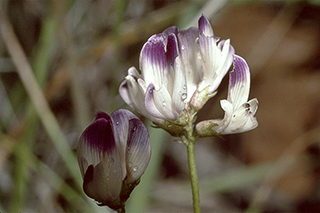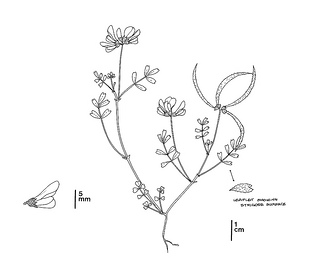(Astragalus claranus)
 Astragalus claranus. Photo by Roxanne Bittman © CNPS.
Astragalus claranus. Photo by Roxanne Bittman © CNPS.
 Astragalus claranus. CDFW illustration by Mary Ann Showers. (Click to enlarge)
Astragalus claranus. CDFW illustration by Mary Ann Showers. (Click to enlarge)
Clara Hunt’s milk-vetch is a California threatened plant species, which means that killing or possessing plants is prohibited by the California Endangered Species Act (CESA). The species is also listed as endangered under the federal Endangered Species Act. Clara Hunt’s milk-vetch is a low-growing annual herb with white and purple flowers that typically appear in March and April. The plants have been found in grasslands and in openings of blue oak/manzanita woodland. The plants have been found on thin, rocky clay soils that are derived from volcanic or serpentine substrates. Six historical occurrences of Clara Hunt’s milk-vetch are recorded in the California Natural Diversity Database: five in Napa County and one in Sonoma County. One of these occurrences has not been seen since 1922 and has probably been extirpated by urban development and conversion of habitat to vineyards. The other five occurrences are presumed to still exist.
All of the occurrences of Clara Hunt’s milk-vetch could be degraded from changes in surrounding land use. Although one occurrence of Clara Hunt’s milk-vetch is protected with a conservation easement and another is located on State Park land, the other three occurrences that are presumed to still exist are all located on privately-owned land. These occurrences on privately-owned land continue to be at risk from direct loss or modification of habitat, primarily from agricultural or urban development. In addition, Clara Hunt’s milk-vetch could be impacted from recreational activities, uprooting by feral pigs, competition with introduced plant species, alterations in natural fire regime and climate change. Furthermore, very small populations, such as those of Clara Hunt’s milk-vetch, can be especially vulnerable to extinction from natural and human-caused events.
A recovery plan for Clara Hunt’s milk-vetch should be completed that outlines actions necessary to reduce the risk of species extinction. An ongoing monitoring program should also be established in coordination with landowners for each of the five extant occurrences to better understand the population dynamics of the species. The threats to the species should also be evaluated, and appropriate management actions should be proposed to reduce the impacts to the species from competition with introduced plant species and uprooting by feral pigs. Management actions that simulate a natural disturbance regime should also be studied. In 1993, CDFW funded Ecological Studies of Clara Hunt's MilkvetchAstragalus clarianus and a Proposal for Habitat Restoration at Conn Valley Road, Napa County (PDF); however, additional research into habitat requirements, life history and restoration options should be conducted.
CDFW may issue permits for Clara Hunt’s milk-vetch pursuant to CESA, and you can learn more about the California laws protecting Clara Hunt’s milk-vetch and other California native plants. Clara Hunt’s milk-vetch occurs in CDFW’s Bay Delta Region. More information is also available from the U.S. Fish and Wildlife Service’s Species Profile for Clara Hunt’s Milk-Vetch.
Updated 01/13/2014